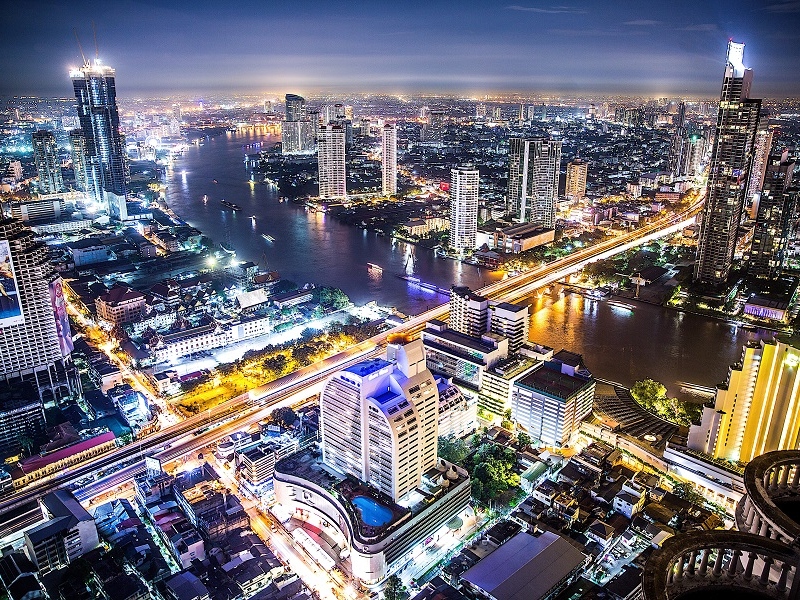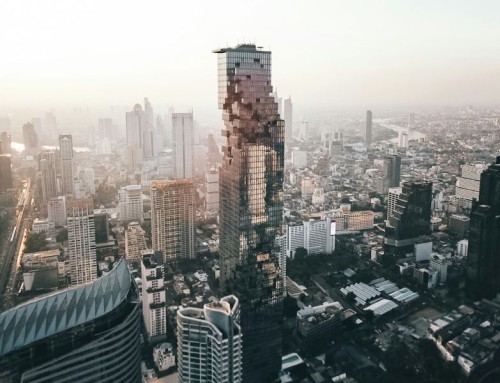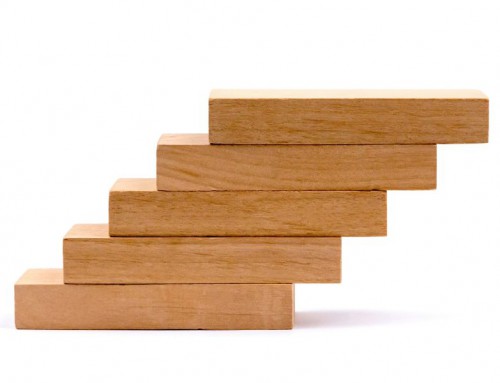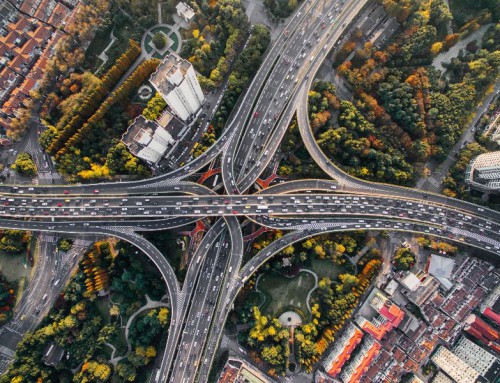Some time back I wrote an article about the good locations for property investment in Bangkok. In it, I highlighted the locations that property investors should be looking at if they would like the best form of property investment in Bangkok. I wrote the article in response to the waves of property launches in Hong Kong, Taiwan, Malaysia, Singapore and I felt that buyers needed a good insight as to where they should look at if they were to purchase a property in Bangkok.
Bangkok is an extremely large city with a size of about 1,568 square kilometres with 8.28 million inhabitants. In contrast, Hong Kong covers an area of 1,106 square kilometres with about 7.45 million inhabitants and Singapore an area of 722.5 square kilometres with 5.61 million inhabitants. Singapore and Hong Kong are the world’s third and fourth most densely populated regions in the world after Macau and Monaco. This gives Singapore a population density of about 7,795 inhabitants per square kilometres, Hong Kong has a population density of about 6,732 inhabitants per square kilometres and Bangkok has a population density of 5,280 inhabitants per square kilometres. Bangkok has a population density of about two-thirds of what Singapore has.
Location has always been the key to a sound property investment plan. Understanding where the central business districts, main shopping belt, popular residential enclaves for the wealthy and expatriates, good schools, government offices and embassies should be paramount to any property buyer. This is also true for Bangkok property buyers. Despite the fact that Singapore is the third most densely populated area in the world, there are still property investors who lose money investing in properties in the city-state. Thus I would implore Bangkok property buyers to do your homework before parting with your hard earned money. In my previous article about the good locations for property investment in Bangkok, I divided Bangkok into 3 categories,
- The Core Central Regions (Siam and Chidlom, Wireless Road and the area around Lumpini Park, The Sathorn area, Nana and Asoke)
- The City Fringes (Phrom Phong, Thong Lo, Ekkamai, On Nut, Asoke and Phetchaburi, Ratchathewi and Victory Monument, The Riverside)
- The Growth Areas (Bang Sue and Tao Poon, Mo Chit and Chatuchak)
If property investors stick to these areas and purchase properties close to the train stations or good amenities, it should put them in good stead for the future. This, of course, would also require that they buy the properties at reasonable market prices. As property prices have been increasing steadily over the past few years, capital appreciation may be limited in the coming years. Growth may still be there but perhaps not at the same pace as previous years. However, many property buyers do look for capital appreciation over rental yield and in this article, I will try to identify the up and coming property investment locations in Bangkok.
Let us first take a look at the current Bangkok train map.
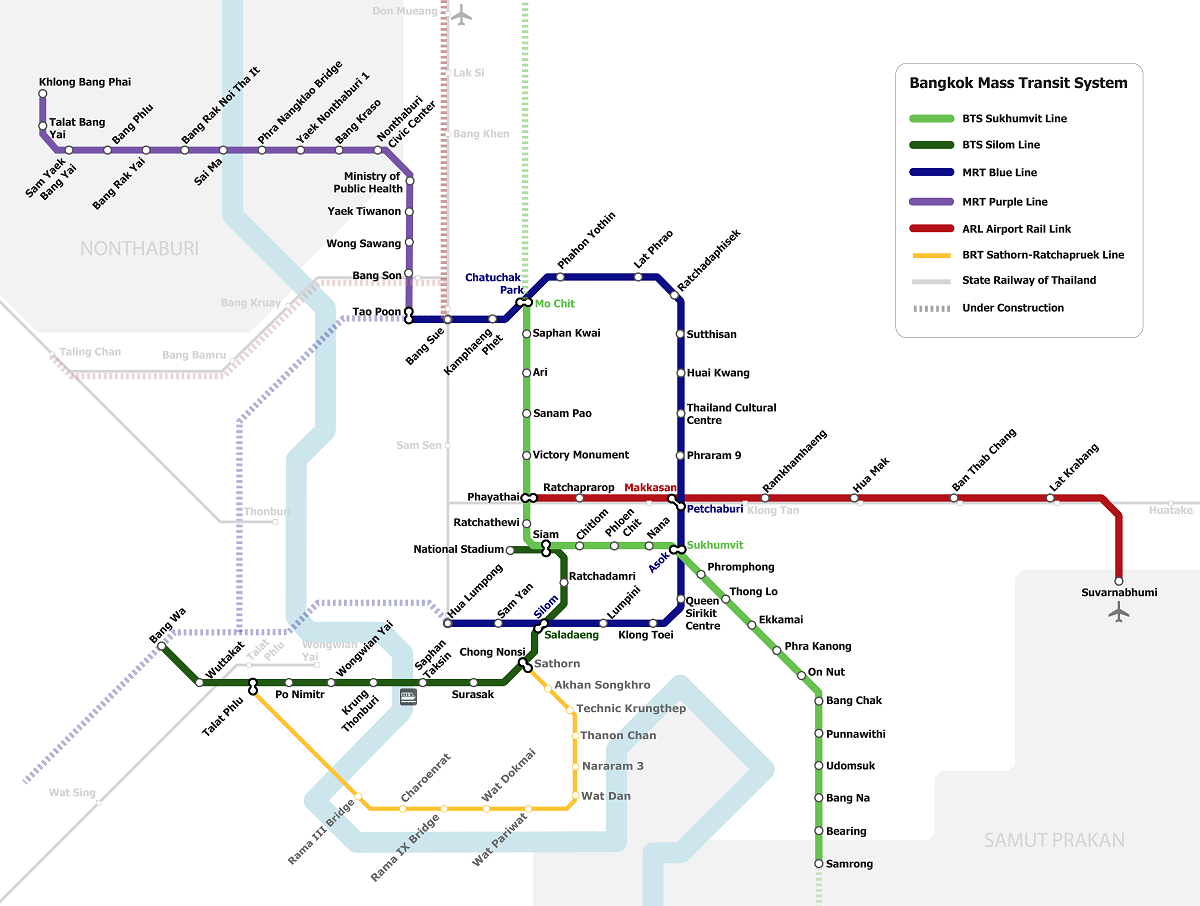
Current Bangkok Mass Transit System Train Map
The current Bangkok Mass Transit System is centred in the heart of Bangkok City. Buyers who have bought in the areas which I had previously stated at fair prices should have done well in terms of capital appreciation or rental yield. Bangkok is adding more lines to their Mass Transit System.
Here are the lines that currently serve Bangkok
- The Sukhumvit Line (BTS Sukhumvit Line)
- The Silom Line (BTS Silom Line)
- MRT Blue Line
- Airport Rail Link
Here are some of the lines that will be added progressively.
- The MRT Purple Line (MRT Chalong Ratchadham Line)
- The MRT Orange Line
- The MRT Pink Line
- The MRT Yellow Line
- The BMA Bang Na-Suvarnabhumi Line
- The BMA Grey Line
- The BMA Gold Line
- The SRT Dark Red Line
- The SRT Light Red Line
Eventually, the Bangkok Transit Map should look like this.

Bangkok and Metropolitan Urban Rail Transportation Masterplan
The MRT Purple Line (MRT Chalong Ratchadham Line)
This line opened in August 2016. It is currently 23 kilometres long and links from Tao Poon to Khlong Bang Phai with a total of 12 stations. There is another planned 19.8-kilometre section from Tao Poon to Rat Burana.
The Bang Sue Grand Station will be located close at Bang Sue MRT Station. The possibility of growth in the area is extremely high. Property investors can consider looking at properties at Tao Poon or one or two stations from Tao Poon. Tao Poon links the older MRT Blue Line to the newer MRT Purple Line. The Bang Sue Grand Station will eventually have four Mass Transit System lines passing through it. The SRT Dark Red Line, the SRT Light Red Line, the MRT Blue Line and the Airport Rail Link. There will also be long distance diesel trains served by the station as well as high-speed rail (HSR) trains leading travellers from Bangkok to Nong Khai, Hua Hin, Chaing Mai and some of these lines will eventually lead to Kunming, China. This is part of the greater Pan-Asia Railway Network as part of China’s One Belt One Road masterplan.
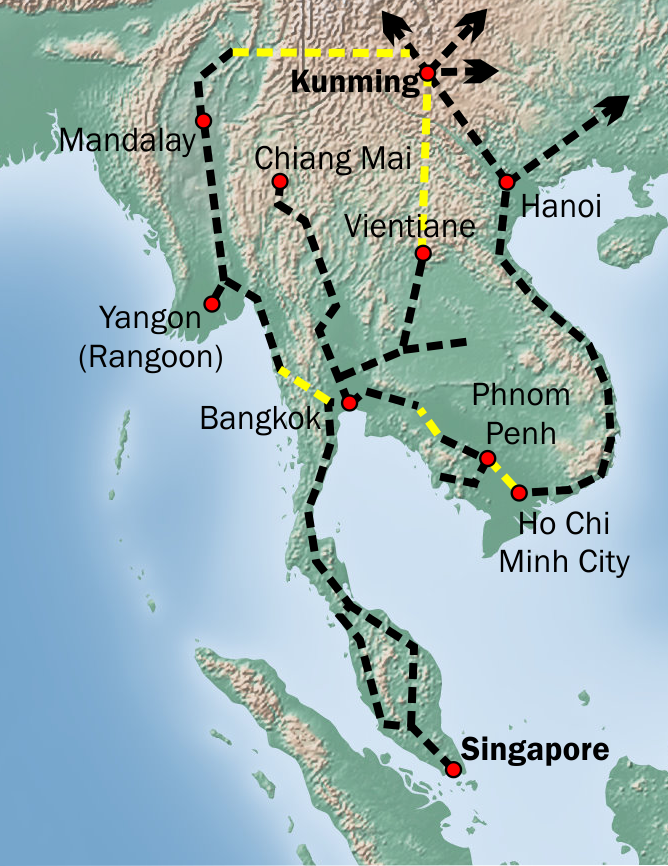
Pan-Asia railway Network
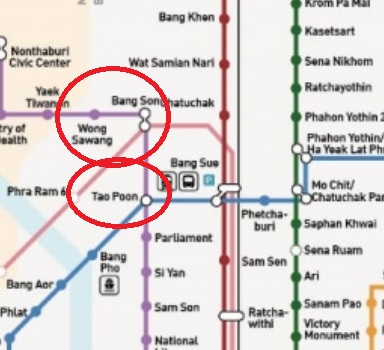
Key stations along the MRT Purple Line
Conclusion: Properties close to Tao Poon, Bang Son and Wongsawang may do well.
The MRT Orange Line
This line is divided into two sections. There will be a 17.5-kilometre section linking Bang Khun Non to Thailand Cultural Centre and another 21-kilometre section that will link Thailand Cultural Centre to Min Buri. Construction has started in June 2017 and the line is projected to open in early 2023.
The MRT Orange Line is significant as it links the new CBD to the heart of Bangkok. The MRT Orange Line will have a station at Pratunam, an interchange with the Airport Rail Link and the upcoming Pink Line at Ratchapraprop as well as another interchange at Ratchathewi.
Thailand Cultural Centre is located next to the Stock Exchange of Thailand and other A-grade offices. The stretch of three stations along the MRT Blue Line consisting of Phra Ram 9 (Rama 9), Thailand Cultural Centre and Huai Khwang has seen steady growth in prices over the past years. Most of the growth has been centred on the area around Phra Ram 9 MRT Station. Rama 9 has been dubbed the new CBD of Bangkok and has seen a steady number of multi-national corporations, top law and accounting firms, banks, set up headquarters in the area. The Unilever headquarters is located in Rama 9. The two stations after Phra Ram 9 are Thailand Cultural Centre and Huai Khwang. Office buildings stretch from these three MRT stations and I do believe that the properties around Thailand Cultural Centre do pose an interesting proposition for property investors as it will be the interchange from the MRT Blue Line to the MRT Orange Line.
Next up I would recommend the properties around Phayathai, Ratchathewi and Ratchapraprop. These areas are at the fringe of the popular shopping belt and are already popular with corporate tenants. As connectivity gets better in these areas, I do foresee that there will be an increased demand for properties around these rail network stations.
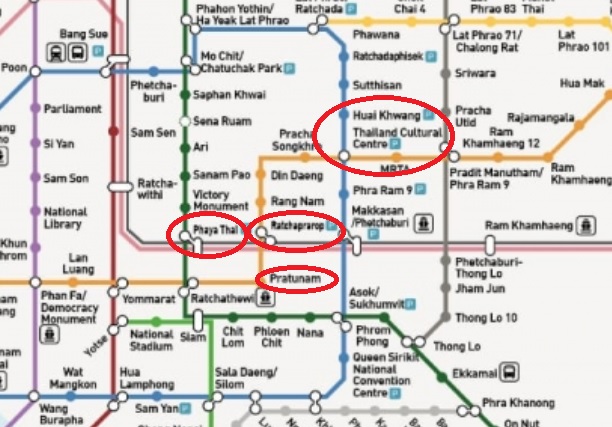
Key stations along the MRT Orange Line
Conclusion: Properties around Thailand Cultural Centre, Huai Khwang, Ratchathewi, Phayathai and Ratchapraprop are already very good locations in today’s context. The connectivity will only get better as rail networks are completed.
The MRT Pink Line (MRTA Pink Line)
The MRTA Pink Line is an above ground mass rapid transit line currently under construction. It will be 34.5 kilometres long with 30 stations and will serve residents in the northern part of Bangkok. Construction started in December 2017 and is slated to complete in 2022.
As the line serves the northern regions of Bangkok and does not link into the heart of Bangkok city, I do not advise that investors look at properties close to the MRT Pink Line.
The MRT Yellow Line (MRTA Yellow Line)
The MRTA Yellow Line is an above ground mass rapid transit line currently under construction. It will be a 30.4-kilometre long line with 23 stations. Preliminary site works started in late 2017 and the major construction started in the 2nd quarter of 2018. It is due to be operational in 2022.
The MRT Yellow Line links to the MRT Blue Line at Lad Prao Station which is located two stations away from Chatuchak and Mo Chit and four stations away from Bang Sue Grand Station. Residents around Lad Prao will also be able to get to Thong Lor by connecting to the upcoming dark grey line at Lad Prao 71/ Chalong Rat interchange. The Yellow Line will also link to the Airport Rail Link at Hua Mak/ Phatthanakan interchange and the upcoming Orange MRT Line at Lam Sali interchange. However, I do not recommend looking at these locations as these are far away from the city centre and are less developed.
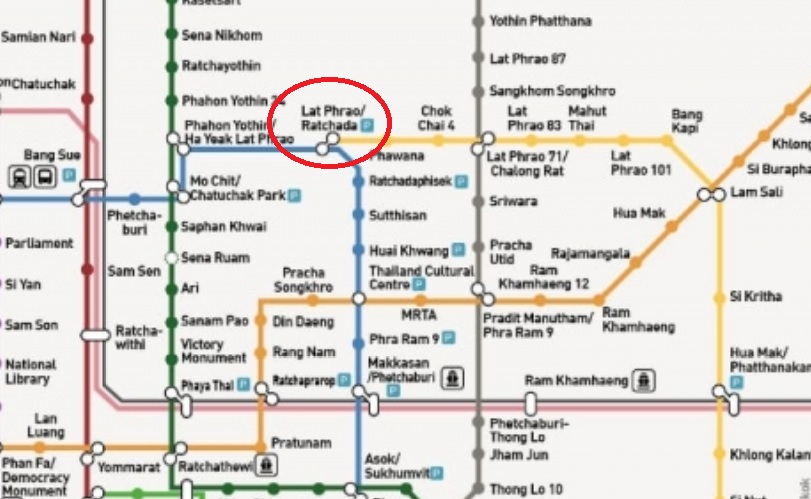
Key stations along the MRT Yellow Line
Conclusion: The MRT Yellow Line only brings up one location that can serve of interest to property investors. Lad Phrao.
The BMA Bang Na-Suvarnabhumi Line
This is a proposed line that has yet to be included in the Mass Rapid Transit Master Plan. It will link Bang Na to Suvarnabhumi Airport. Bang Na is located along the current BTS Dark Green Line. The Mega Bang Na mall serves the large local community in this area. Bang Na is a very popular location for the locals. Ikea and The Marvel Experience Bangkok is located next to Mega Bang Na Mall. Bang Na BTS is located four stations away from On Nut BTS. In my personal opinion, the cut-off point for property investment should be at On Nut as tenants usually do not look further than On Nut BTS Station. Since this line has yet to be confirmed, we can revisit this when they do.
Conclusion: We will review this when plans are more concrete. Even then, only Bang Na should serve as the possible point of interest. For now, there is not much to take note here.
The BMA Gray Line
Although the map lists it as BMA Dark Grey Line and BMA Light Grey Line, the line should be continuous and it should be a singular BMA Grey Line. This is a proposed line, thus the confusion, which has yet to be confirmed but in my personal opinion, this is one of the most important lines linking the outskirts of Bangkok to Thong Lor and then leading into the CBD and then along the riverside. This is a north-south line that will lead up to the upcoming MRT Pink Line from the Green BTS Line. There are a few proposed stations to take note of.
Thong Lo 10
This is at Thong Lo Soi 10. This is the heart of where the high-end establishments are and have been one of the most popular locations for wealthy Thais as well as the expatriate community, namely the Japanese. As it is currently, property prices are already one of the highest in Thong Lo. If the station gets confirmed, expect the interest for properties in this area to pick up a couple of notches.
Phra Khanong and On Nut
Currently already extremely popular with tenants, these areas are filled with amenities and thus very popular with tenants due to the convenience. The Grey Line should run through this area on-route to the Sathorn Financial District, Bangkok’s original CBD. Having a line that cuts the journey to the CBD should bring increased demand to the area. Currently, you will need to take the BTS down to Siam BTS interchange or Asoke BTS/ Sukhumvit MRT and make a switch to get to stations in the CBD like Sala Daeng, Silom, Chong Nonsi and Surasak. Despite the emergence of Rama 9 as the new CBD of Bangkok, the Sathorn Financial District still houses a significant number of high-end corporations and has the highest concentration of business offices.
Rama 4
Currently, with no access to any train line, Rama 4 Road runs parallel north of the main Sukhumvit Road. It has easy access into the Sathorn Financial District via taxi and thus tenants do look for properties in this area. The commute is extremely quick into the CBD as the roads along Rama 4 are generally less congested than the main Sukhumvit Road.
The area around Chong Nonsi
This is truly the heart of the Sathorn Financial District. If there was one major gripe about the area, it is congestion. Having a train line that will serve to alleviate the stress on the current train lines will come as a huge relief to travellers. There are many who are put away by the massive congestion in this area. Having better connectivity will only serve to improve the conditions and perhaps bring more interest back to this area. Demand for properties in this area is one of the highest but most are looking to rent their properties out to people who work in this area. Buyers usually do not buy for own stay because of the congestion. This thinking is similar for both local and overseas investors. Stations to take note of are Lumphini, Chong Nonsi, Narathiwas and the surrounding areas.
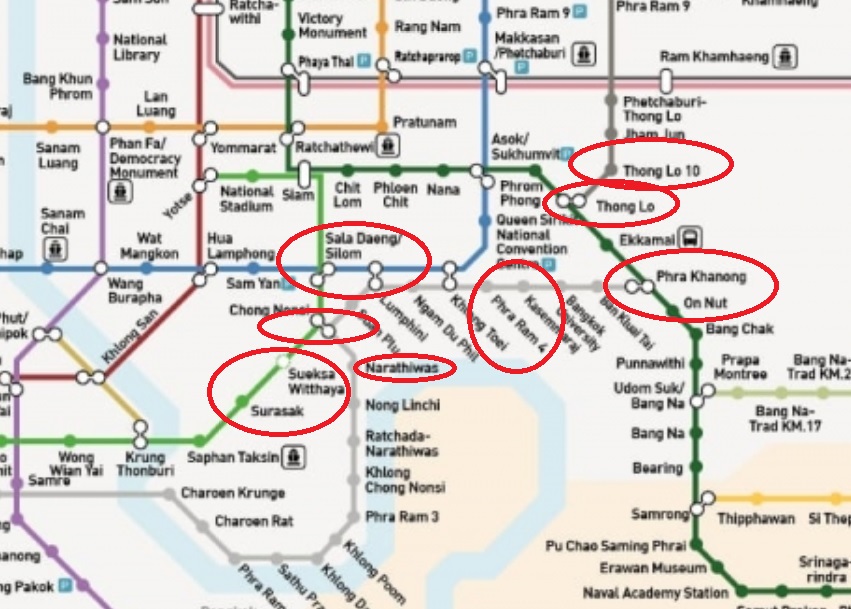
Key stations along the BMA Grey Line
Conclusion: I do think that this line will happen as it serves as an important link through Thong Lor, Phra Khanong, On Nut and right into the heart of the Sathorn Financial District and then out towards the riverside. If it really does happen, places like Thong Lo Soi 10, Phra Khanong, On Nut, Rama 4 and the area around Chong Nonsi will see an increased demand for properties in these areas. Currently, as it stands, these places are already one of the most prime areas in the whole of Bangkok. Even without the Grey Line, it would be fine to include properties around these areas in your property portfolio.
The BMA Gold Line
This is an extremely short line that will connect Krung Thonburi BTS Station with Prajadhipok Road in Thon Buri District. The line will have a total distance of 2.68 kilometres and will connect the BTS Light Green Line to the upcoming SRT Dark Red Line and the upcoming extension of the MRT Purple Line. It should have 3 stations. It is expected to open in 2023.
Conclusion: This is not significant as it is on the wrong side of the Chao Phraya River. It serves the less urban side of the Chao Phraya River.
The SRT Dark Red Line
The SRT Dark Red Line is rather significant as it will Bangkok Province and four adjoining provinces. In short, it is designed to bring people from other provinces to Bangkok. It will be 87 kilometres long and as of September 2017, 89 per cent of the civil works had been completed. It is scheduled to open in phases and the first phase is scheduled to open in October 2020. The significant stations will include the Don Mueang, Bang Sue, Yotse and Hua Lamphong. I do not think that a station at Don Mueang will cause an increase in the demand for properties in that area so do take note of this point when someone tells you otherwise. It will just promote connectivity to that airport from other parts of the city. Even in Singapore and Hong Kong, properties around the airport are not the most prime and when the train station was built to connect the airport to the rail network, it did not bring about a spike in property prices. For the areas around Bang Sue, Yotse and Hua Lamphong, I do believe that this line should have a bearing on properties in these areas.
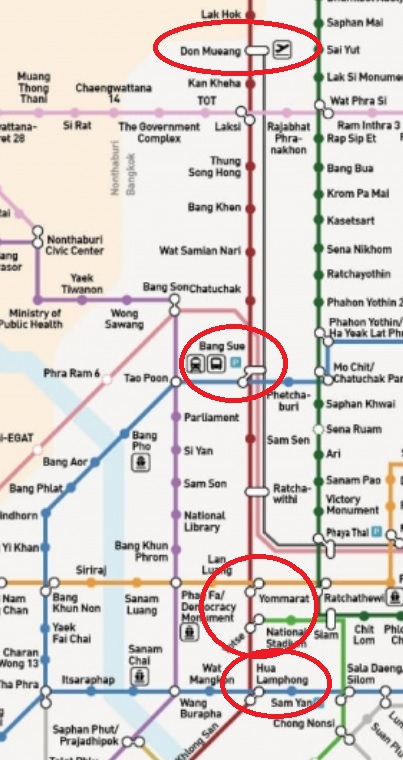
Key stations along the SRT Dark Red Line
Conclusion: You may consider the properties close to National Stadium BTS and Hua Lamphong. However, I do think that the stations along the Grey Line are better located than the ones along this Dark Red Line.
The SRT Light Red Line
The Light Red Line will run east-west from Sala Ya to Hua Mak Railway Station in Bangkok. It should run past Suvarnabhumi Airport eventually. The segment from Tailing Chan to Bang Son, which is 15 kilometres long, is already completed and opened for a free trial service in December 2012. Services were eventually suspended in January 2014 due to a lack of ridership. In July 2016, the Thai cabinet approved the construction of the Bang Sue-Phayathai-Makkasan-Hua Mak segment of this rail line. The tender for construction is expected to happen by the end of 2018. This line is not very significant to the whole master plan but it does connect the other provinces to Bang Sue Grand Station. The point to note would be that there will be a station at Phayathai.

Key stations along the SRT Light Red Line
Conclusion: Look at Phayathai once again. And perhaps Ratchaprapro. This line will link Phayathai to the Bang Sue Grand Station. Phayathai is looking like a very well connected area. It will eventually have easy access to both airports and the Bang Sue Grand Station. As it is currently, Phayathai is already one of the better locations for property investors.
The extensions to the existing BTS Dark Green Line, BTS Light Green Line, MRT Blue Line and Airport Link Line
I am not going to add many recommendations to my recommended stations along the existing lines. The main reason for the extensions is to cast a wider rail network to reach out to the less urban parts of Bangkok. I can only highlight the following areas as places to highlight. They are an extension from the usual locations which I have previously mentioned in my article the good locations for property investment in Bangkok.
Locations that should benefit to a large extent
Phayathai
It seems like this location gets mentioned a lot but I do think that there is great potential for properties in this area because of the fact that it is going to be an intersection of so many important lines. Yet Phayathai is a mere two BTS Stations from Siam BTS. The location is already one of the better locations which you can consider if you are looking to invest in Bangkok properties. It is already the interchange between the Airport Rail Link and the Sukhumvit BTS Dark Green Line.
Thong Lo, Ekkamai, Phra Khanong and On Nut
Thong Lo is already one of the most expensive areas to buy a property in Bangkok, values should increase once the BMA Grey Line is confirmed. Upon completion, it will bring greater connectivity to Thong Lo and the surrounding areas.
Chong Nonsi
Congestion is a major issue in the Sathorn Financial District. The extension of the BTS Light Green Line will connect to the extension of the MRT Blue Line at Bang Wa as well as the SRT Light Red Line and MRT Orange Line at Tailing Chan. Thus passengers do not need to pass through the city centre interchanges like Siam BTS interchange and Asoke/ Sukhumvit interchange to get to other parts of Bangkok. This should bring back the appeal of living in Sathorn as many are currently drawn away because of the congestion.
Bang Sue and the area around it like Bang Po, Mo Chit and Chatuchak Park
I do think that the Bang Sue Grand Station will have a significant impact on Bangkok as a whole. Extending the MRT Blue Line would make the MRT Blue Line into a loop. Getting to the city centre from Bang Sue would mean making use of the Mo Chit/ Chatuchak Park Interchange.
These are my recommended areas for property investors looking for up and coming property investment destination locations in Bangkok. As you can see, a lot of it is centred around connectivity and the potential spillover from the Bangsue Grand Station. Bangkok is located in a geographically advantageous location in the centre of South East Asia to take advantage of China’s One Belt One Road plans. That being said, any form of invest has an element of risk. My article is to serve as a guide of property investors in Bangkok and I base my recommendations on my experience in dealing with Bangkok properties since 2012. There are many instances whereby properties which are located far off from the city centre with little to no potential for price appreciation or rental demand are purchased by unwitting investors outside of Bangkok. I hope that my article can serve as a useful aid but investors should still do their own due diligence to know what they are buying.
Yours Sincerely,
p.s. I run a Bangkok property portal, InvestBangkokProperty.com and a property company in Bangkok and I am basing my recommendations on my experience dealing with the primary, rental and resale market in Bangkok since 2012. My recommendations are personal and do not represent the views of any company.
My other articles about Thailand property
1) The good locations for property investment in Bangkok
2) A compelling case to invest in Bangkok
3) Guide to buying a property in Thailand
4) Thailand Property: Legal and Tax Issues
5) Recognising the different property title deeds in Thailand
6) Can a foreigner take a property loan in Thailand?
7) Buying property in Bangkok: Payment procedures
8) A guide to the top property developers in Thailand
9) Thailand Property Market Outlook for 2018
10) Thailand as a retirement destination
11) How to get a Retirement Visa in Thailand
12) My personal experience purchasing a property in Bangkok
13) Things to take note when investing in an overseas property
14) Factors that determine the property price in Bangkok
15) Looking to buy a Bangkok condo? Things to take note of.
16) Thailand property inheritance laws: taxes, succession and wills
17) The good locations for property investment in Bangkok (2023 update)
